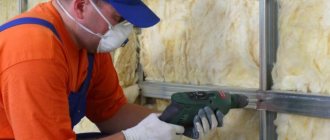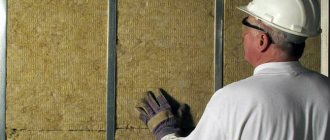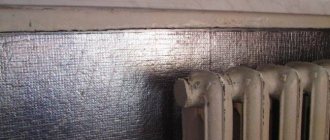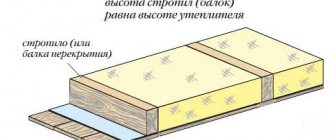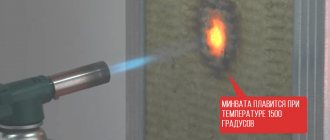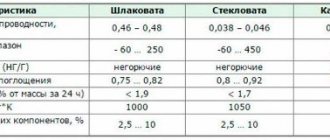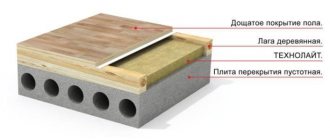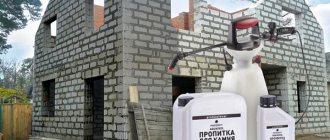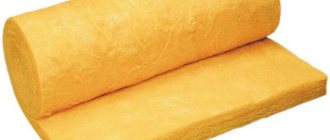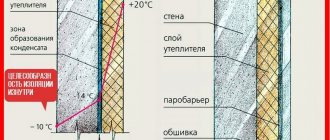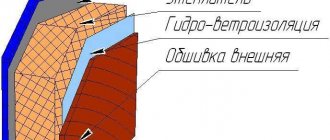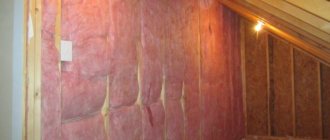Features of internal insulation
Unfortunately, internal insulation is not as effective as external insulation of premises, but with the right approach it can be a good way out of the situation. The main problem with this method is that the load-bearing wall itself, bordering the street, does not become warmer.
IMPORTANT! The so-called “dew point” (the boundary of the cold wall and the insulation layer) shifts to the surface of the finishing layer , which inevitably leads to the appearance of dampness and the eventual destruction of the wall and finishing layer. These negative consequences can be avoided during internal insulation by using special hydro- and vapor-tight membranes.
At the same time, despite its disadvantages, insulating walls from the inside also has its positive aspects:
- such work can be done with your own hands;
- insulation of internal walls with mineral wool can be done at any time and in any weather;
- there is no need to complete all the work at once - it can be done gradually;
- Insulation with such a device plays the role of sound insulation and prevents extraneous street sounds from entering the home.
Pros and cons of insulation methods
Lack of insulation from the inside - freezing
When insulated from the inside, not only with mineral wool, but also with any heat insulator, the wall is protected from heat, so its temperature decreases.
Moreover, with a sufficiently large amount of insulation, the wall can freeze through. Freezing a structure is always bad, because for any material there is a finite number of freezing cycles before its destruction. It’s even worse if the wall freezes while wet. In this case it will be so.
Humidification, dew formation
The dew point - the temperature at which dew falls from the air - will be located directly on the wall.
More precisely, condensation may begin to fall in the insulation, but the cold surface of the wall will also condense water on itself. And there will be a lot of water, it will also flow onto the wall from the insulation, especially if you use mineral wool.
A wet wall will grow excellent “greasy” mold and large colonies of putrefactive microorganisms. All this will be located indoors, spreading from the wet collapsing wall along the ceiling, floors... Residents will need means of rescue.
Finally, when insulating from the inside, the heat insulation and finishing will take up part of the usable space. The usable area of the room will decrease by about a square meter. It's a lot.
The above disadvantages can be circumvented and leveled out (except for eating up the usable area). But only if mineral wool is not used for internal insulation.
Mineral wool is moisturized and accumulates water
Mineral wool is not suitable for insulation from the inside, even in forced situations, due to its properties. This insulation perfectly allows water vapor to pass through itself and can accumulate water inside, becoming simply wet.
It is clear that when insulating from the inside, the insulation will become wet due to the dew point in it and the lack of ventilation. The consequences are known.
The material consists of tiny fibers of basalt or other minerals. It is also made from blast furnace slag and silicates (glass wool), these samples are cheaper. To bind the fibers together, phenol-formaldehyde resins are used, the same as in the production of chipboard.
Mineral wool owes its good thermal insulation to the air trapped between many interwoven fibers. If the air is replaced by water, at least partially, then the required thermal insulation qualities will disappear.
Even a slight increase in humidity (by 2%) of this insulation leads to a significant decrease (up to 8%) of its thermal insulation properties.
Features of thermal insulation of internal walls with mineral wool
This material consists of tiny fibers of minerals, such as basalt. In order for the fibers to bind together, phenol-formaldehyde-based resins are used, just as in the manufacture of particle boards. Despite the fact that mineral wool can accumulate water, it is an excellent heat insulator.
It is endowed with such properties thanks to the air that is hidden between the various intertwined fibers. However, if all the air accumulated inside is displaced by water, then a significant part of the thermal insulation qualities of the wall will be lost. For this reason, mineral wool is afraid of even the slightest moisture.
In all places where this heat insulator is used, it is necessary to ensure high-quality ventilation of the room. A ventilation gap must be made behind the insulation layer, and it is advisable to wrap the wool itself with a vapor-permeable membrane. It will minimize the movement of water condensate and particles of the material itself, which is unsafe for the respiratory tract.
In cases where it is necessary to insulate the walls from the inside with mineral wool, additional vapor barrier may not even be used. The wall itself will serve as an obstacle to the entry of steam into the heat insulator, while on the reverse side we have provided air circulation through vertically located channels. Mineral wool is used to protect any structure of a building.
You should also pay attention to the microscopic size of the fibers in the case of insulating internal walls with mineral wool. When they are heated, they release resins that are carcinogenic.
Of course, no one prohibits the use of material for insulation work, but it must be reliably protected from living quarters. It is optimal if toxic fumes are vented outside and not inside the room. It is unacceptable for microfibers to spread throughout the room itself. It is necessary to work with such material using additional protective equipment.
Note! One of the varieties of mineral wool is a material coated with foil on one side. Despite the fact that it is recommended for insulating ceilings, it is also successfully used for thermal insulation of walls.
Mineral wool, what is it?
Mineral wool is a fibrous or layered material based on mineral raw materials. Hence the name. There are three types in this category:
- glass wool;
- slag;
- stone wool.
Firstly, all insulation materials differ from each other in raw material. Secondly, each of them has different fiber sizes, so the quality characteristics are also different.
Glass wool
It is based on the raw materials that are used to make glass; even cullet and glass production waste are used. Dimensions of insulation fibers: length – 14-50 mm, thickness – 4-15 microns. Thermal conductivity – 0.028-0.052 W/m K. Operating temperature from -60 °C to +500 °C.
Slag
The raw material is blast furnace slag. Fiber sizes: length – 15-16 mm, thickness – 4-13 microns. Thermal conductivity – 0.45-0.48 W/m K. Maximum heating temperature up to +300 °C. This species is very hygroscopic.
Experts warn that slag wool should not be used on metal surfaces. The thing is that residual acidity is always present in slags. When interacting with moisture, the acid begins to corrode the metal.
Stone wool
This is the most common type in this category. And when it comes to mineral wool, it means stone wool. Therefore, in what follows we will not distinguish between these two concepts.
So, let's start with the fact that mineral wool is made from different types of stone. Therefore, it has different characteristics in terms of density and thermal conductivity. If the insulation is made of limestone, dolomite, and so on, that is, non-solid rocks, then the thermal conductivity can vary from 0.077 to 0.12 W/m K. If the insulation is made of basalt (diabase or gabbro), then the thermal conductivity of such a material is 0.03 -0.05 W/m K.
At the same time, soft rocks contain many impurities in their structure, which means that the fibers are weakly connected to each other. Therefore, more formaldehyde is added to them during the production process. Such materials can withstand temperatures up to +600 °C. Basalt mineral wool up to +1000 °C. Stone wool today is sold in mats (blocks), in rolls and in loose form.
Advantages and disadvantages of mineral wool
The spread of mineral wool is primarily due to its advantages:
- low thermal conductivity;
- non-flammability;
- mechanical stability - does not change its properties when exposed to it;
- soundproofing characteristics;
- resistance to temperature deformation;
- biochemical resistance;
- convenience and ease of installation.
However, despite the impressive list of advantages, building regulations do not recommend using ordinary mineral wool for insulating premises . This is caused by the presence of phenol in its composition, which has a detrimental effect on human health. For internal insulation, craftsmen advise using ecowool or stone wool.
If installed incorrectly, exposed areas of mineral wool come into contact with the ventilation system, resulting in hazardous particles being released into the surrounding air.
Technology of thermal insulation of walls with plasterboard from the inside
The technology of insulating the walls of a room with plasterboard from the inside does not require special training of workers or expensive equipment. General construction skills and a universal tool are enough.
Tools and materials
During the work you will need:
- guides (metal profiles or wooden bars);
- gypsum boards;
- insulation in slabs or rolls;
- double sided tape;
- vapor barrier membrane;
- screws, dowels and other fasteners;
- anti-mold agents;
- putty;
- drill;
- screwdriver;
- hand tool.
The floor in the room must be cleared of debris and foreign objects.
Preparatory work
First, leveling is carried out, as well as cleaning the walls from dirt and dust. It is important to completely remove old plaster and paint, if any. For wooden houses, the surface of the walls is additionally treated with construction antiseptics in several layers. This is necessary in order to prevent the destruction of the surface of the wood, its rotting and to extend the service life of the entire building. For brick buildings, walls are treated with antifungal compounds.
Electrical wiring that is already installed in the room must be unfastened so that insulation is not placed on top of it. The platbands, window slopes and other fastening elements from the walls are being dismantled so that the heat insulation layer is not damaged. The walls must be completely dry before installation. After completion of the preparatory work, the main ones are carried out, such as:
- caulking (sealing) cracks;
- creating a vapor barrier;
- installation of sheathing;
- laying mineral wool with calculation of the ventilation system;
- creation of external vapor barrier;
- exterior finishing work.
Sealing cracks
Any house has a tendency to shrink and sag. Often cracks, cracks and other gaps form inside the walls, which interfere with the thermal insulation process. To eliminate this, all these errors should be eliminated by caulking them. The most suitable material for this is jute. It is an inexpensive, environmentally friendly, rot-resistant material. Caulking must be done evenly over all walls.
Vapor barrier
As already noted, the disadvantages of mineral wool include excessive wetting. To prevent this from happening, it is necessary to provide a vapor barrier. So, a special film is laid with the smooth side facing the insulation and the rough side facing the wall. A construction stapler is used for fastening. The joints are sealed with construction tape.
Lathing
To install mineral wool, it is necessary to provide a frame. To assemble it, you can use a wooden beam measuring 50x50 mm or a profile for attaching drywall. The frame is fastened with self-tapping screws or using dowels and nails. It is important to avoid distortions; for this you should use a level.
The sheathing is installed in a vertical position if roll insulation is used. For horizontal placement, insulation in mats is used.
Laying the material
It is worth noting that the mineral wool that comes in rolls is laid vertically, and the tile insulation is placed between the sheathing bars themselves. The material is fastened using anchor nails. There should be no gaps or cracks on the surface of the material. The structure should be dense and uniform.
After installing the insulation on the frame, a vapor barrier film is laid on top with the rough side facing the mineral wool. This is necessary to protect the room from basalt dust and other hazardous substances that may enter the air.
Finishing
To attach drywall or other finishing material, you need to install another frame. But its sheathing must be perpendicular to the first. That is, if the first one was horizontal, then this frame should be vertical.
Internal wall insulation with mineral wool and plasterboard finishing
- insufficient distance between individual buildings;
- a ban on changing the external appearance of the facade (if, for example, the house has historical or any other value);
- irreparable defects of the facade;
- the adjoining of the façade walls to non-residential premises of a technical nature (elevators, staircases).
Preparing the wall and treating it with an antiseptic, antifungal solution (if there is already mold on the surface of the wall, it needs to be washed with special solutions and then dried with a hair dryer).
- by filling the air gap of a brick wall with foam chips or polyurethane foam;
- by external cladding of the facade with expanded polystyrene and mineral wool;
- through internal thermal insulation.
Surprisingly, even on their own, without insulating material, plasterboard sheets are capable of insulating a house (of course, only if they are well reinforced and there are no gaps between the sheets). This property is inherent in plasterboard for the reason that it has low thermal conductivity - 8-10 times less than, for example, a reinforced concrete slab. Both in stone and wooden private houses, there must be not only internal thermal insulation, but also external, because only together they can ensure reliable and high-quality insulation of the house.
Nevertheless, there are cases when it is not possible to carry out external thermal insulation, in which case the only option may be internal insulation of the walls with mineral wool and plasterboard covering.
- The sheets are fastened to the frame using metal screws. The standard length of gypsum board is 250 cm. If the height of the room is greater, a piece of the required size is cut from a new sheet. In this case, the installation of sheets is carried out staggered - so that the position of the segments alternates.
- If necessary, a second layer of plasterboard is installed.
- The drywall is being cleaned.
Today it is difficult to imagine renovation without the use of drywall. It is multifunctional and is used for finishing walls, ceilings, creating partitions, and various decorative elements. The foam is attached to a special glue, which is prepared with the addition of water. Each individual piece must fit tightly with the adjacent one.
If gaps form between them, they are filled with polyurethane foam. After the adhesive mixture has dried. The foam is additionally fixed with plastic dowels and umbrellas.
In this case, fastening is carried out end-to-end so that the caps fasten adjacent sheets, and 1-2 dowels are hammered in the middle. Penoplex is extruded foam plastic, but with high density and strength. Insulating walls with penoplex will cost more, the price per square meter is about 200 rubles. Even though a layer of internal thermal insulation steals the usable area of the room, it has a number of advantages. Work can be carried out regardless of weather conditions, without the need to additionally level the walls.
It often happens that, for a number of reasons independent of a person, it is impossible to carry out facade insulation with your own hands. For example, if the apartment is located on the upper floors of a high-rise building. Therefore, in such a situation, installing mineral wool inside and outside the rooms is the only correct solution. The same applies to other situations: Well, where would we be without them, even the best material necessarily has some disadvantages. Mineral wool also has one, but very significant drawback: it absorbs a lot of moisture, and when wet, its thermal insulation properties are reduced.
With an increase in humidity by only 1%, the thermal conductivity of the material rises by 8-9%. Many consider such material characteristics as good vapor permeability as a disadvantage, arguing that high vapor permeability leads to the accumulation of condensation on the insulation.
- It is possible that there are shortcomings in the heating system - there is not enough total thermal power.
- Another option is the unsatisfactory condition of windows and ceilings, through which cold air constantly passes through.
- The reason may also lie in poorly thought out ventilation - a large amount of heat is lost along with air exchange.
- You should pay attention to the thermal insulation of floors and ceilings - these are also “favorite ways of heat loss in a building.
The calculations take into account that the air in the room (on average - 0.13 m²× ° C / W) and outside (0.04 m²× ° C / W) have a certain thermal resistance.
Installing mineral wool
To install insulation on any surface, a working frame or additional partitions are required. The simplest and most effective partition for mineral wool is best made from plasterboard sheets. Builders and ordinary people, depending on their preferences, lay mineral wool in one of two existing ways. In the first case, it is placed behind the drywall, in the second, the insulation is placed in the partition. We will now look at how this is done specifically in each case.
First way
Special fastening brackets are installed on the wall for the profiles to which the drywall will be attached. They are placed vertically with a distance of approximately 50-60 centimeters from each other and screwed to the surface. Almost four to five fastening brackets will be installed on the same line, which is quite enough for both the CD profile installed under the frame assembly and the fastening of mineral wool sheets. We bend the screwed brackets in the shape of the letter “P”. Ultimately, there will be peculiar horns on the entire surface, ready to accept mineral wool. We unravel the roll or take out layers of mineral wool from the bale (depending on the form of the material) and measure out the required fragment depending on the need. At the same time, we give some tolerance. For example, for a wall 2.6 meters high, you should add a margin of ten centimeters - after all, this is not a rigid material, wool can be deformed, so if there is no margin, it may happen that some part of the space will not be covered with insulation.
We place the prepared strip of cotton wool on the mounting brackets protruding from the insulated surface. Considering the properties of cotton wool, it can easily be pierced by a staple and will hang securely in a vertical position. Similarly, we adjust and install the material in a horizontal position. The next strip is installed like an accordion. By installing mineral wool in the recommended way, you will continuously and tightly cover the entire planned surface with insulation.
After completing the installation of thermal insulation material in the inner surface, it should be remembered that we still have to install profiles for installing plasterboard sheets, and mineral wool, despite the fact that it is already on the wall, continues to be a source of danger for humans - it continues to be present in its composition a certain concentration of carcinogen and formaldehyde. So you should not relax and all further work must be carried out with extreme caution and in compliance with the above safety measures.
So, we stopped at the stage of installing profiles for covering the installed mineral wool with plasterboard sheets. The LED profile is installed using the usual method (described above), however, we again protect our hands with gloves from the effects of material particles. If we use mineral wool without foil, then first we install a waterproofing barrier on top of the insulation and profiles (there is a large selection of waterproofing materials on the construction market). Thanks to this, the room will receive additional protection from the side effects of mineral fibers. To completely complete the wall insulation using this option, all that remains is to cut out the necessary fragments from the plasterboard sheets and attach them to the profile.
Second way
We make a working frame on the wall surface for attaching drywall. In the usual, previously described way, we mount metal profiles. Now you can fill the frame space with mineral wool. But since we have already used the mounting brackets, the insulation strips should be laid in a different way. In this case, it is assumed that the distance between the profiles does not exceed 40 centimeters, and the width of the mineral wool strip is in the range of 50-120 centimeters. Thus, you can use the often used “accordion” method - the insulation should be passed under the profiles one strip after another. With a small distance from the profile to the wall, the wool can be layered to the desired size. No gaps should be made; the entire surface should be tightly covered with insulation! Even minimal holes in a constructed, albeit very warm, blanket can significantly reduce the thermal insulation of a room.
When carrying out work on stretching strips of mineral wool under the profiles, care should be taken not to spoil the insulation with fastening brackets placed on the surface.
Having completed the installation of mineral wool, some people are in no hurry to cover the insulation with plasterboard, but on top of the mineral wool, for the purpose of additional protection from carcinogens and formaldehydes, they apply a layer of dense cellophane film and only after that they cover the structure with plasterboard.
Vapor barrier in different rooms
There are different levels of moisture evaporation in the bathroom, bedroom or kitchen. Therefore, you should consider how to install the vapor barrier material on the frame.
Step-by-step process of waterproofing a bathroom
In the bathroom
Watch the video: waterproofing in the bathroom.
When working in the bathroom, the sequence of actions is as follows:
- First, the frame of the selected type is installed.
- Then a heat-insulating layer of material is mounted into the frame (if provided).
- After this comes the moment of fixing the vapor barrier layer into the frame structure.
- Depending on the selected material (vapor barrier film or membrane film), the sheets are secured either with a profile or immediately fixed with a sheet of plasterboard. When installing vapor barrier material on the surface, you should be extremely careful. It is necessary to check that there are no cracks or gaps between the sheets.
The installation of vapor barrier material in other rooms is carried out in the same way.
It is preferable to opt for waterproofing the bathroom using mastic.
Necessary places for waterproofing in the bathroom
In wooden houses
There are some differences in the process when installing a vapor barrier layer in a wooden house. Plasterboard coverings are popular in wooden houses. The main thing is to adhere to the process technology in order to do everything correctly.
Vapor barrier in a wooden house under a wooden frame
The wooden facade of the house is prone to corrosion and fungi. Therefore, it is best to install a vapor barrier coating on both sides of the insulation so that moisture and dampness coming from the wood do not reach the surface of the plasterboard sheets. To do this, you can first fix the vapor barrier sheets on both sides before installing the insulation into the frame. This will remove excess moisture from the surface of the drywall and wood.
Vapor barrier in a wooden house under a metal frame
It is not difficult to install vapor barrier material under plasterboard floors. The main thing is to weigh the important nuances and decide what materials you need to buy and which installation option is most relevant.
The main thing is to decide what goals are set, and you also need to pay attention to the cost of the material. A narrow selection of vapor barrier materials prevents you from getting lost in a multitude of ideas
Watch the video: attaching a vapor barrier in the attic under a metal profile and to aerated concrete walls.
How much will it cost to insulate an apartment internally?
Improving living conditions is very good, but a reasonable question arises: how much will such comfort cost? Let us immediately note that the number of factors influencing the price is very large. And a lot depends on the type of finishing work you choose. We will give approximate prices specifically for the insulation process, without further finishing work, because prices for wall paint vary by 5 times depending on the manufacturer and type of paint.
On average, one meter with material and auxiliary materials (vapor barrier, antiseptic) starts at 200 rubles (100 UAH, $4) per m2. The cheapest materials were used in this calculation. So, a room with an area of 18 meters along the walls has approximately an area of 47 m2. Using simple calculations, we get the cost of 9,400 rubles (4,700 UAH, $188). Let us clarify once again that these figures are for informational purposes only and do not include finishing work.
The process of proper insulation with your own hands
- First you need to clean the wall surface from any remaining finishing material. A good example is the insulation of a brick wall with mineral wool on the side of the home. At the end of the cleaning process, the wall should be completely bare. If there are traces of mold, they must be removed with a spatula.
- At the next stage, the existing cracks and cracks are thoroughly sealed. To seal large and small flaws, you can use polyurethane foam or building mixtures.
- Upon completion of installation, it is necessary to remove dust from the room with special care. Good cleaning results can be achieved using a vacuum cleaner. This is necessary so that the anti-fungus and mold agents cover the surface being treated well, destroying harmful organisms where they are not visible to the eye. It is also recommended to use antiseptics for treating walls for preventive purposes.
Installing mineral wool in the frame yourself
It is worth mentioning safety precautions when working with mineral wool. Regardless of the type, the material can be volatile, which means you will have to wear a mask and gloves when working. It is also recommended to wear long sleeves and not to work in shorts. It is prohibited to store food and drinking water in the work area.
The first stage will be the actual production of the frame. It is assembled from bars made of wood or metal profiles. The first option is suitable for finishing with chipboard sheets, the second - for drywall. The required width of the bars is from 40 to 50 millimeters, the depth should be at the same level as the thickness of the insulation sheet. The vertical gaps between the frame lines should be in the range of 50 to 60 centimeters. The corners must be decorated with frame elements.
The next level is insulation with mineral wool from the inside. Take note - mineral wool is very elastic. Unwinding a roll or unpacking a bale, as well as measuring the required length, must be done taking into account a margin of approximately 10 centimeters. This will avoid bottlenecks when applying material. Fastenings can be staples, which are usually used to connect sheets of drywall, only in this case they will press the material.
Some features should be taken into account. If sheet insulation is used for internal insulation of the house, you need to install horizontal strips. This will help avoid pressure from the upper fragments on those located at the bottom of the structure.
When choosing insulation, you should take into account both its width and the width of the structure as a whole. It will be nice if the size of the material fragments exceeds the width of the cells by several centimeters (from 3 to 5 is enough).
After laying the material on the insulated surface, they proceed to installing the vapor barrier. Materials for it are produced in the form of rolls. If the insulation contains foil, then there is no need for a partition between the layer of mineral wool and the sheathing. If a vapor barrier is necessary, then it is laid on the wall, to which it is attached with construction tape or an adhesive base. Laying is carried out with the obligatory creation of an overlap.
If the house has a low level of sound insulation, installing mineral wool as internal insulation will help cope with this problem without additional costs, since the material perfectly muffles sounds entering the house from the outside.
Upon completion of this stage, the thermal insulation can be considered complete, after which you can begin sheathing and finishing the surface of the walls.
About mineral wool, dew point and insulation features
As a rule, houses made of brick and wood are subject to insulation. This is mainly a legacy inherited from parents and grandmothers. The walls are physically worn out and require not only repairs, but also additional thermal insulation. Insulating brick walls from the inside with mineral wool is used in many cases when it is necessary to combine high-quality insulation with the use of inexpensive insulating material.
Mineral fibrous material is characterized by a layered porous structure. The air contained in the pore cells retains heat well and “muffles” noise. Cotton wool has a low thermal conductivity coefficient, high frost resistance, and a low degree of ignition, provided that it is in a dry state.
Compactly packaged, whether in rolls or slabs, cotton wool facilitates transportation and installation. Due to its elasticity and ability to take the desired shape, such insulation can be laid even on uneven walls: the wool takes the shape of all chips and potholes, tightly stopping them. Another bad thing: when working with the material, you need to provide water protection, because... The slab resembles a sponge that intensively absorbs moisture. Another “minus” is the chemical composition of the insulation. When laying it, you should protect your respiratory system and skin from toxic components.
Note! The thermal insulation layer must be of a certain design thickness. A change in this characteristic leads to a shift in the “dew point”. The thicker the slabs, the more the thermal insulation layer will protrude into the room, and the dew point, on the contrary, will move further and further into the layer.
A wall insulated from the inside, given the difference in temperature outside and indoors in the cold season, is not completely warmed up by the internal heat of the building. The “meeting” of warm (from the room) and cold (from the street) air masses is transferred from the inner wall surface to the inner layers of the wall. Condensation appears on it, dampness forms. This harms both the walls and the thermal insulation layer.
| Indicators | Units | Minvata |
| Coefficient of thermal conductivity | W/ms | 0,049 |
| Apparent density | kg/m.cub. | 55-150 |
| Compressive Strength | MPa | not standardized, since load resistance is minimal |
| Water absorption, no more | % | is not standardized, since the humidity resistance is minimal; the calculations use the figure of 4% |
| Effective service life, not less | years | 10 |
| Operating costs (specific damage rate) | damage year/100 km | 30-40 |
Using drywall as insulation
Drywall, or gypsum board, is a thin sheet of gypsum, lined on both sides with layers of thick paper. Drywall has good strength and a perfectly flat surface, which is convenient to paint or wallpaper. It is easily mounted on prepared guides; you can cut the sheet into pieces of the required size and shape with a regular mounting knife.
All this makes gypsum board one of the most popular finishing materials. Can it also serve as insulation? By itself, no. Its thermal conductivity is determined by the thermal conductivity of gypsum, it is only half that of brick and ten times higher than that of mineral wool or other thermal insulation materials. In order for drywall to effectively retain heat, its layer must be several tens of centimeters.
However, the structure of the guides, which are mounted to install gypsum board on walls or ceilings, can be effectively used to place real insulation in it - sheets of mineral wool or foamed plastics. The surface of the plasterboard sheet will cover the thermal insulation from mechanical influences.
Using drywall
When doing insulation using mineral wool from the inside, experts recommend additional external insulation. Unfortunately, this is not always possible in apartment buildings, and interior work remains the only option. Drywall, which has many advantages, will help solve this problem.
- When installing, there is empty space between the drywall and the wall. If conditions are favorable, you don’t have to fill it with insulation. Gypsum is able to retain heat inside without additional materials.
- The method of fastening drywall allows you to fill the frame of the structure with any type of insulation.
- Plasterboard sheets hide all the unevenness and defects of the wall.
- You can carry out finishing with any materials (wallpaper, paint, plaster).
- Drywall allows you to create a variety of decorative elements (arches, niches, protrusions).
- For rooms with high levels of moisture, moisture-resistant material is available for sale.
Plasterboard sheets are attached to a pre-prepared metal profile frame. The guide profile is attached to the floor and ceiling. The main thing is to align it with the wall so that in the end the new plasterboard sections are level. The vertical components of the system are inserted into the guides, which must be attached as efficiently as possible to obtain the required rigidity. Vertical strips are mounted at a distance of 60 cm from each other so that the sheets can be fastened both along the perimeter and in the center.
After this, horizontal parts are inserted into the frame. When installing them, you need to take into account the dimensions of the drywall sheets, since it will be attached to both vertical and horizontal elements. It is preferable to use whole sheets of drywall for installation. If in some places you cannot do without trimming, mark and cut off the required piece. The material must be fastened in a checkerboard pattern. Thus, the joints will be at different levels.
Which basalt wool is better to choose?
The effectiveness of wall insulation with basalt depends on the correctly selected insulation and compliance with insulation technology. Among the criteria by which it is necessary to choose insulation: the thickness and density of the mats, as well as the manufacturer.
Thickness. The thickness of stone wool for wall insulation depends on the climatic zone in which the house (the apartment is located) is built and on the type of walls: concrete, brick, wood or frame.
For central Russia, an indoor insulating layer of basalt 50 mm thick copes with its function perfectly. For a facade, a thickness of 100 mm is needed, for a frame house - 150-200 mm.
If you wish, you can use an online calculator to more accurately calculate the thickness of the insulation.
Density. The thermal conductivity of the material (the lowest for insulation with a density of 60-80 kg/m3) and the rigidity of the slabs depend on the density indicator. The rigidity indicator is very important when insulating a frame house, where a lot of pressure is applied to the bottom row and when finishing work is carried out directly on the insulation (decorative plaster).
The density of basalt wool for wall insulation should be within:
- 50-75 kg/m3 for frame houses;
- 80-130 kg/m3 for walls with a gap for ventilation;
- 130-160 kg/m3 with the “wet” method of insulation;
- 150-175 kg/m3 for a concrete facade.
It is better to buy basalt fiber wool from reputable manufacturers on the market. At the same time, it is not necessary to strive to purchase mats with the brand “PAROC” or “Rockwool”. They have high quality, but the price is also very high.
Other manufacturers' quality fully complies with European and Russian standards, and the cost is an order of magnitude lower. Therefore, why overpay for a trademark if there are products from TechnoNikol, Isover, URSA, and Beltep (Belarus).
Selecting the type of wool
Mineral wool has been used as a building material for quite some time. It is made from basalt fibers. The material is environmentally friendly and perfectly retains heat inside a home made of wood or brick.
Types of mineral wool:
By type of use:
- lightweight - with a density of 10-90 kilograms per cubic meter. Suitable for use in insulating frame houses;
- heavy - with a density of about 90 kilograms per cubic meter. used for facade insulation of buildings;
- technical - serves as an insulator for premises and equipment for industrial purposes. Can withstand both high and low temperatures.
By composition:
- Glass wool is a product of melting quartz sand or broken glass. It consists of the finest fibers interconnected by special substances that give the material the yellow tint that we are used to seeing. The material is not flammable and is not able to absorb moisture and its vapor.
- Slag wool - products are produced by processing industrial waste. For residential premises, insulation with this type of wool may be unsafe, since the environmental friendliness of the material is at a low level.
- Basalt wool is highly in demand for home insulation. Has an increased thermal conductivity coefficient.
- Stone wool is the most high-tech product. It may be the best choice when insulating residential buildings, since it is almost free of the disadvantages inherent in other materials under consideration.
Calculate the insulation of your home
The required amount of mineral wool is not selected at random, but taking into account the weather conditions of a particular region.
In the Moscow and Leningrad regions, for example, the climate is temperate and continental. Here it is recommended to insulate the house with mineral wool slabs with a thickness of 8 to 10 cm. The further north you are from these places, the greater this figure will be. In the Murmansk region, the optimal thickness of wool for wall insulation will be about 15 cm.
A material whose density is less than 40 kg/cubic meter is used exclusively on horizontal surfaces that are not subject to load (this is the kind of mineral wool that is usually produced in the form of rolls).
For insulation of external walls, the density is in the range of 50–75, and for creating a ventilated facade - all 110, and even more if the surface is still covered with plaster.
Mistakes made when insulating
In order for the insulation of the walls of the house, from the inside, done with your own hands with mineral wool, which will be covered with plasterboard on top, to last as long as possible, it is important to avoid common mistakes:
- an attempt to save money when purchasing thermal insulation material from little-known manufacturers;
- non-compliance with the sequence of thermal insulation work;
- laying mineral wool with various types of defects;
- there are gaps between adjacent sheets of material;
- improperly equipped vapor barrier or its complete absence.
It often happens that while doing the work with his own hands, the homeowner forgets to install sockets or a switch in the drywall . If you carry out installation work on installing electrical products after fixing the drywall, you can significantly damage the insulation. Therefore, this procedure must be performed in advance.
As you can see, insulating mineral wool under drywall is not the most difficult process; the main thing is not to forget about high-quality vapor barrier and distribute the mineral wool in an even layer from the inside over the entire surface of the walls. This procedure will keep the house warm and prevent the formation of drafts and other troubles.
Useful tips and nuances of internal insulation
If possible, it is advisable to carry out insulation from the outside, as this is most effective. In addition, this allows you to neutralize the harmful effects of cold on the walls. Naturally, this does not apply to wooden buildings , where it is necessary to lay a thermal insulation layer both inside and outside the room.
Experts recommend that before installation work, a calculation of the thermal characteristics of the building is carried out, thanks to which it is possible to correctly select the thickness and characteristics of the insulation. Even when individual sections of the walls freeze, they provide thermal insulation around the perimeter of the entire room. If the building has high humidity, then foil insulation is used.
When doing all the work with your own hands in a brick or wooden building, it is important to ensure that the markings are applied correctly. The rolled insulation must be opened in advance so that the mineral wool takes on its original dimensions. If glass wool is used as insulation, then all work on its installation is carried out only with the use of protective equipment . You cannot proceed to the main work until the fungus and mold, as well as other damage to the walls, have been eliminated in the room.
Many experts also recommend laying insulation under the metal profile or using polyurethane foam. Mineral wool must be properly leveled so that it acquires its natural position without dents, deflections or waves. In the case of multi-layer laying of thermal insulation, the seams should not be allowed to coincide.
Some good tips
- To avoid mistakes, you must follow the instructions exactly;
- For high-quality installation of the material, the slab must have a width of more than one meter;
- In order for mineral wool for wall insulation to last longer, it is necessary to create a high-quality vapor barrier;
- The material should lie tightly and evenly on the surface. When filling the grate with insulation, it is important to avoid gaps;
- Insulating walls with mineral wool slabs is much easier than using mineral wool in rolls;
- The wall on which the insulation is applied must not have cracks or defects.
Well, I would like to hope that this article will help the reader understand and understand what mineral wool is, what properties it has, and how to use it correctly to save heat in the house. Let insulating walls with mineral wool seem like an easy job with a positive result for everyone!
Sheathing with gypsum board sheets
The advantages of using plasterboard are obvious - it is an inexpensive, but very high-quality material with which you can decorate walls in any room. At the same time, it goes well with frame structures. Since it is adjusted to the size of the gypsum board sheets, there will be a minimum of trimming. The design is easy to assemble:
- On the sheets, use a marker to mark the places where the screws will be installed. Then a hole is drilled for them.
- To ensure that the fasteners do not subsequently stand out, take a drill one size larger and use it to create a recess of a larger radius in which the head is buried.
- The sheets are fixed on bars.
- The joints are glued with special tape and plastered.
- At the end, finishing is done. It can be carried out by any of the publicly available methods.
That's all. As you can see, insulating walls from the inside with mineral wool does not look like an impossible operation. With a little effort and perseverance, you can achieve results without having any special skills.
Video “Insulation of walls from the inside with stone mineral wool”
Sources
- https://expert-dacha.pro/stroitelstvo/steny/uteplenie-st/minvata-plyus-gipsokarton.html
- https://teplodom1.ru/penoplast/86-uteplenie-iznutri-minvatoy-oshibki-s-sereznymi-posledstviyami.html
- https://x-teplo.ru/uteplenie/steny/iznutri-minvatoj-plyus-gipsokarton.html
- https://StroyGuru.com/remont-kvartiry/steny/tehnologiya-utepleniya-sten-bazaltovoj-vatoj/
- https://mr-build.ru/newteplo/uteplenie-sten-iznutri-minvatoj-plus-gipsokarton.html
- https://pro-instrymenti.ru/strojka/kak-uteplit-dom-mineralnoj-vatoj/
- https://SovetPoRemonty.ru/steny/uteplenie-sten-iznutri-minvatoj.html
- https://ProUteplenie.com/steny/iznutri-minvatoy
- https://odnushka.ru/steny/uteplitel/minvata
- https://iv-proect.ru/steny/uteplenie-sten-iznutri-minvatoj-plyus-gipsokarton.html
- https://rusolymp.ru/raznoe/yteplenie-sten-iznytri-minvatoi-tehnologiia-i-poleznye-sovety
